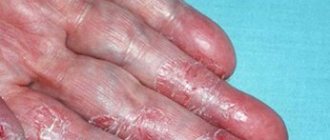Of all known skin diseases, atopic dermatitis is the most insidious. It is quite difficult to identify it, make an accurate diagnosis and treat it. The signs of atopic dermatitis, as a rule, do not differ from the symptoms characteristic of other skin pathologies, but they have some features. Often people do not even realize that they are sick; they try to cure skin irritation with ordinary cosmetics and folk remedies. Sometimes the symptoms go away, but after some time atopic dermatitis appears again with a number of complications. To avoid this, it is necessary to recognize dermatitis in time and understand the causes and mechanism of its development.
Causes of development of atypical dermatitis
Atopic dermatitis is an inflammatory, chronically relapsing pathology of the skin, accompanied by constant itching, as well as eczematous and lichenoid rashes. The disease is also called allergic eczema, as it very often occurs at the same time as:
- bronchial asthma;
- food allergies;
- allergic rhinitis;
- conjunctivitis;
- ichthyosis. [12]
Atopic dermatitis most often develops in childhood - the prevalence among children reaches 15-30%; in 9 out of 10 cases it develops in the first year of life. The incidence in adults is 2-10%. Women suffer from it more often than men. Most cases occur in cities with high levels of pollution and cold climates. [3]
This is an immune-dependent pathology. The reasons for its development are associated with mutations in genes that are responsible for the synthesis of filaggrin, a structural skin protein involved in the formation of the stratum corneum, which, in turn, is responsible for the barrier functions of the skin. Like a brick wall, the stratum corneum of the epidermis retains water and does not allow a large number of allergens and microorganisms to enter the body. In patients with dermatitis, the synthesis of filaggrin is impaired, and the connections between the cells of the stratum corneum are damaged. Because of this, the skin retains moisture worse and is more sensitive to any external influences. The mechanism is as follows: the pathogen enters the body through damaged skin, and the immune system produces immunoglobulins. Against the background of these processes, symptoms of atopic dermatitis arise. [4]
What substances cause allergies?
Food allergens are any substances, most often of a protein nature, that stimulate the production of immunoglobulin E (IgE) or the cellular immune response.
The products that most often cause allergic reactions are grouped by experts into the “Big Eight”. It includes: cow's milk, chicken eggs, soy, peanuts, tree nuts, wheat, seafood and fish.
Cow's milk protein
(BKM) is the main allergen. Most often, true allergy to cow's milk occurs in the first year of life and accounts for 2–3% among infants. But over the years, the child develops tolerance to this protein (that is, tolerance, resistance): by the age of 5, approximately 80% of children do, and by the age of 6, the incidence drops to less than 1%.
It must be remembered that the milk of other mammals, including goats, also has allergenic properties. It can either cause cross-allergic reactions in patients with allergies to CMP, or be an independent allergen.
Of course, allergy to CMP occurs more often in bottle-fed children. Too much foreign protein comes from the formula. Due to the immaturity of the intestinal barrier and as a result of the immune response, infants develop early sensitization (hypersensitivity) to cow's milk protein. But breastfed children may also develop an allergy to CMP due to the penetration of food proteins into breast milk.
In a chicken egg
13 protein allergens are determined. Children with an allergy to chicken egg whites develop tolerance in 4% of cases by age 4, and in 12% by age 6.
Soy can often be the cause of allergic reactions.
or products with soy protein.
Quite often, allergies are caused by cereal products.
, primarily wheat gliadin, gluten of rye, barley and oats, less often - proteins of corn, rice, buckwheat. Usually the first signs appear during the introduction of complementary foods, when the child is “introduced” to cereals.
In fish and seafood
There is a protein that is practically not destroyed during cooking. It is found in many types of fish. Allergies to fish usually do not go away with age, persisting in adolescents and adults.
Allergens from fish and seafood can cause severe systemic reactions when even a very small amount of the allergen enters the body.
Peanut
, like peas, beans and soybeans, belongs to the legume family. Peanut proteins contain a lot of allergens. Peanuts are widely used in the food industry, so it is worth remembering that they often become a “hidden allergen”.
Different foods can cause cross allergic reactions due to the presence of proteins that are similar in structure. More than 90% of children with an allergy to cow's milk protein develop cross-allergic reactions to goat and sheep milk.
Factors provoking the disease
A genetic mutation does not cause atopic dermatitis on its own. The disease develops under the influence of provoking factors. Most often these are atopenes - allergens to which the immune system produces antibodies. These include:
- food allergens - cow's milk, wheat, crayfish, crab, soy, chocolate, citrus fruits;
- pollen atopenes – wormwood, ragweed;
- dust pathogens - animal hair, dust, bed mites, molds. [5]
Some foods (smoked meats, sweets, hot spices, alcoholic drinks), medications (antibiotics, vitamins, sulfonamides) and cosmetics (perfumes, decorative cosmetics) can also lead to the development of atopic dermatitis in children and adults.
Factors due to which a person can develop dermatitis are divided into external and internal. Some of the external factors have already been mentioned, but they also include:
- climatic conditions;
- evaporation of solvents such as turpentine and acetone;
- harmful working conditions;
- environmental pollution with smoke and toxic fumes of aggressive substances. [5]
Internal factors are associated with other diseases of the gastrointestinal tract and endocrine system, as well as viral infections.
Many scientists believe that severe emotional stress and hormonal changes are also risk factors for developing atopic dermatitis. [6]
Nutrition for a nursing mother with a child allergic to cow's milk
Excluded:
- all products containing protein from cow's milk and the milk of other mammals, beef;
- eggs, peanuts, nuts, fish, seafood, soy;
- products that often cause both allergic and non-immune (“false allergic”) reactions (caviar, mushrooms, honey, chocolate, coffee, cocoa, citrus fruits, kiwi, pineapples, avocados);
- broths, marinades, salty and spicy dishes, canned food, smoked meat and fish, spices; products containing artificial colors, flavors, preservatives;
- carbonated drinks, kvass;
- sauerkraut, radishes, radishes, fermented cheeses, ham, sausages, smoked meats, pickles, marinades and other products that cause the production of histamine;
- products that irritate the gastrointestinal tract and change the taste of milk - onions, garlic, radishes, radishes.
Allowed (subject to portability):
- vegetables and fruits (mostly green, white);
- vegetarian soups; meat - lean pork, turkey fillet, rabbit in boiled, stewed form, and also in the form of steamed cutlets;
- cereals (buckwheat, corn, rice, oatmeal, millet, pearl barley);
- pasta;
- bread - 2nd grade wheat, wheat-rye;
- vegetable oils, ghee;
- tea, compotes, fruit drinks from dimly colored fruits.
If breastfeeding is maintained, a complete diet for the mother should be prepared and calcium supplements prescribed. To maintain the protein part of the diet, you can use medicinal mixtures based on amino acids.
It is necessary to exclude allergens, including cow's milk protein, from the diet of the child and/or mother for at least 6 months. However, after the acute symptoms of allergy in the child disappear, the mother’s diet can gradually expand under the control of tolerance to other foods.
Breastfed infants with severe manifestations of PA (for example, severe atopic dermatitis or allergic enterocolitis with growth retardation and/or severe anemia) can be temporarily excluded from breast milk and prescribed a therapeutic mixture of amino acids or highly hydrolyzed protein for 2 weeks.
Symptoms of atopic dermatitis
Depending on the age of patients with dermatitis, the symptoms of the disease can be very different. There are three phases of atopic dermatitis:
- infant - from 7-8 weeks to 1.5-2 years;
- children's - from 2 to 12-13 years;
- adults - from the onset of puberty and older. [6, 7]
Beginning in infancy, atopic dermatitis lasts until puberty, and even until the end of life, often with remissions of varying duration. As a rule, symptoms are most pronounced in infancy and early childhood. In infants, the symptoms of atopic dermatitis include dry, scaly and itchy plaques that appear on the head, forehead and cheeks, and the outer elbows and knees. In children over 2 years of age, the manifestations are more extensive - rash and redness, dryness and flaking of the skin, as well as constant itching of the affected skin, which becomes rougher and thicker. In this case, atopic dermatitis affects the elbow and knee folds, wrists, ankles, neck, and buttock folds. An exacerbation of the disease is observed at the ages of 7-8 years and 12-14 years. [8]
As for symptoms in adulthood, we are talking specifically about episodic exacerbations of atopic dermatitis after many years of remission. They are characterized by:
- inflammation that starts from the elbow or knee folds, the back of the neck and spreads to the arms;
- pronounced dry skin with very severe peeling;
- incessant itching. [8]
Diagnostic diet
Currently, there is no single generally accepted diagnostic test on the basis of which a diagnosis of PA can be made. The diagnosis is established on the basis of the clinical picture, the results of an allergological examination with food allergens, as well as on the basis of the complete disappearance of symptoms after prescribing a diet with the exclusion of the product from the diet (elimination diet).
When a child has symptoms and there is a high probability of an allergy (for example, an allergy in parents or close relatives), a diagnostic elimination diet is prescribed to exclude foods containing this protein. When breastfeeding, such foods are excluded from the mother's diet.
The duration of the diet may range from 3–5 days in children with immediate reactions (eg, swelling, vomiting, skin manifestations within 2 hours) to 1–2 weeks or more in children with delayed or chronic reactions (eg, atopic dermatitis). If the child has gastrointestinal symptoms (eg, enterocolitis), it may take up to 4 weeks to evaluate the results of the diet. Keeping a food diary is of great benefit during this time.
If an allergy to CMP is suspected, a diagnostic dairy-free diet is prescribed. The effectiveness of such a diet can be assessed within 2–4 weeks, depending on the nature of the reactions (immediate or delayed type) and the nature of the allergy (acute or chronic process).
Diagnosis of skin pathology
At the moment, there is no specific laboratory test that can detect atopic dermatitis. The diagnosis is made based on the symptoms present and an assessment of the severity of the disease. The severity of atopic dermatitis is determined using the SCORAD scale, which includes a number of objective and subjective criteria. The first includes the strength and prevalence of lesions, the subjective - the intensity of itching during the day and night. [9]
To establish atopic dermatitis, it is necessary to identify specific IgE antibodies to allergens. For this purpose, cutaneous patch tests are performed, but only if the patient has delayed-type hypersensitivity.
Atopic dermatitis is often confused with other diseases. To avoid mistakes, differential diagnosis is carried out using laboratory tests:
- detection of platelet pathology;
- determination of immune status;
- microscopy of scales. [9]
Sometimes, to distinguish atopic dermatitis from other pathologies, the localization of the rash is sufficient. So vulgar psoriasis affects the extensor surfaces, while the manifestations of atopic dermatitis are localized in the flexor areas.
What complications can there be?
If atopic dermatitis is not properly treated, the disease will develop and lead to complications. Like manifestations, the severity and severity of complications are directly related to the age of the patient. The infantile phase is characterized by complications of atopic dermatitis such as candidiasis and Kaposi's eczema herpetiformis. In childhood, staphylococcal impetigo, molluscum contagiosum and chronic papillomavirus infection are observed. Complications in the adult phase are represented by dermatophytosis and keratomycosis. [10]
Without treatment, atopic dermatitis can significantly reduce the quality of life of the patient and his family. Discomfort is primarily associated with a person’s appearance - with dermatitis, noticeable itchy spots appear on the body, which cause anxiety among others. And although atopic dermatitis cannot be contracted, people are wary of patients and do not want to come into contact with them. Patients experience a continuous desire to scratch the inflammation, so their posture and facial expression look tense and repulsive. Therefore, when it comes to dermatitis, one cannot fail to mention the neurotic and psychological syndromes that this disease entails.
Treatment with Akriderm drugs
Akriderm preparations are products for the local treatment of manifestations of atopic dermatitis with a wide spectrum of action. Thanks to the combined composition, including a glucocorticosteroid, an antibiotic and an antifungal component, the products have several effects at once:
- anti-inflammatory;
- antiallergic;
- vasoconstrictor;
- antipruritic. [12]
Since atopic dermatitis can occur in both acute and chronic forms, Akriderm preparations are available in the form of ointments and creams. This allows you to choose the most appropriate remedy based on the course of the disease, the severity of manifestations and the presence of secondary infection. Active substances penetrate deeply into the source of inflammation, fighting not only pathogens that provoke atopic dermatitis. Treatment is also aimed at combating attached microorganisms. Thus, Akriderm preparations have a bacterial and antifungal effect. [13]
A well-thought-out formulation of the drugs makes it possible to use them in the treatment of atopic dermatitis in children over 2 years of age. [14, 15]. Other advantages of Akriderm preparations for the topical treatment of atopic dermatitis include:
- convenient release form – 15 g and 30 g;
- reasonable price - the cost of a 30 g package is more profitable for the buyer compared to 15 g of a similar product; [16]
- over-the-counter status, which makes Akriderm preparations one of the most accessible means for treating manifestations of dermatitis.






